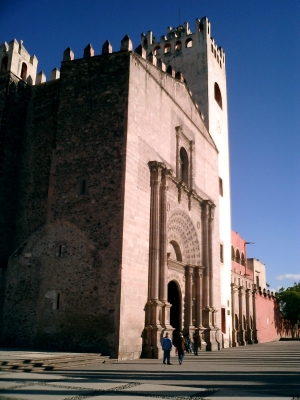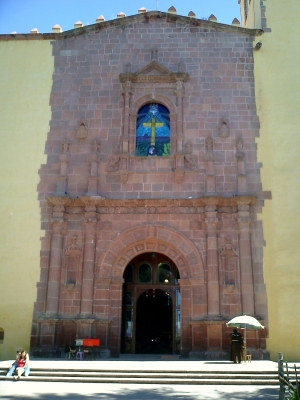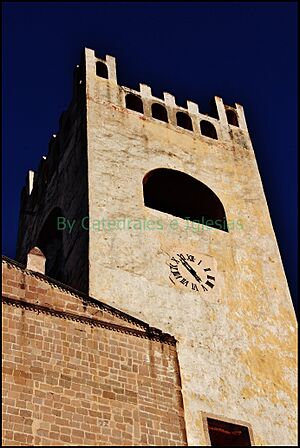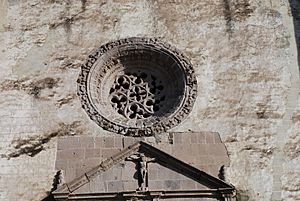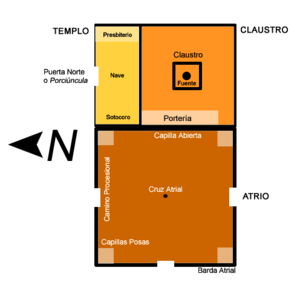Mendicant monasteries in Mexico facts for kids
Mendicant monasteries in Mexico were special buildings. Friars (religious brothers) built them in the 1500s. They helped teach Christianity to the people in New Spain (what Mexico was called then). These friars belonged to groups called 'mendicant orders.' They lived simply and often traveled to spread their faith.
These buildings were designed to teach many Native American people. Soon, they became important centers for towns. They taught people about Western ways of life. This included the Spanish language, different arts and crafts, health, and even funeral services.
The buildings used older architectural styles. These included Romanesque and Gothic styles, which were not common at the time. They were based on European monasteries, like Cluny Abbey. But they also added new features. These included the atrial cross and the capilla abierta (open chapel). They also looked like strong fortresses.
Inside these buildings, you can find unique art. This art was made by Native American artists. It was based on European designs but guided by the friars. This style is called tequitqui or Indochristian art.
Why Were These Monasteries Built?
The friars wanted to show their beliefs through these buildings. They used architecture, sculptures, and paintings. They were inspired by ideas about a new, perfect church. They wanted to restart the church in the New World.
The friars were given the job of teaching the Native Americans. So, they made the monasteries full of teaching tools and symbols. The buildings had special images and designs. These showed what the friars had learned from spreading Christianity in Europe, Asia, and Africa.
The monastery buildings looked old on purpose. They used building ideas from many centuries earlier in Europe. But they built them with the techniques of the 1500s.
Romanesque Style Features
- The size of the main halls (naves)
- The thickness of the walls
- The use of buttresses (supports), flying buttresses, and rounded arches
- Bell-gables, which are wall structures that hold bells
- Sculptures on the outside walls
- Barrel vaults, which are rounded stone ceilings
Gothic Style Features
- A feeling of reaching upwards
- Decorative ribbed vaults (arched ceilings with raised ribs)
- Round rose windows made of stone. You can see an example in Yecapixtla, Morelos.
- Pointed arches
- Segmental arches, like a basket arch, often found in the cloisters (covered walkways)
Mudéjar Style Features
- Decorations made with yeserías (plasterwork)
- Use of alfarjes (wooden ceilings with patterns)
- Spaces with many arches. An example is the chapel of San Gabriel Franciscan Convent in Cholula.
The mendicant buildings of the 1500s looked similar to European monasteries. They had similar layouts, decorations, and building styles. This was because the friars used building guides from Europe. They kept the buildings symmetrical and measured. They copied older monastery designs from the 4th century. These designs had strong, thick walls and buttresses, like military forts. They were similar to European forts built to protect against invaders.
How Monasteries Were Built
The buildings were planned to go back to the early Christian church. They had special spaces designed to follow the rules of Saint Benedict of Nursia.
The Atrium
The atrium was a unique feature in New Spain. It was a large open space, like a big plaza. It was used for large church services. Over time, it became the main social center for Native American towns. It was where European ways of life were taught. This included arts, crafts, the Spanish language, and religious rules.
The atrium's main purpose was for religious events. This included Mass, processions, and plays. Native Americans enjoyed these plays, which helped teach them about Christianity. They were used to outdoor ceremonies, so they accepted holding Mass outside.
Atrial Cross
In the center of the atrium, a stone cross was placed on a base. This cross was a symbol of the town's founding. It also had symbols of Jesus's suffering.
Atrium Wall
A wall surrounded the atrium space. This wall was often decorated with battlements (like on a castle) and fine finishes. It also reminded people of the coatepantlis, which were walls around Native American ceremonial centers.
Processional Path
Processions were very common. Their path was marked around the edge of the atrium wall. This was done with shrubs, small walls, or trees.
Capilla Posa (Resting Chapel)
At the four corners of the atrium, four chapels were built. These were unique to New Spain. They had vaulted ceilings and decorations. Their purpose was for resting the Blessed Sacrament during processions after Mass. Each chapel was cared for by a different neighborhood of the town. So, they were also called "community chapels" or "Native American chapels." Examples can be found in Huejotzingo and Calpan in Puebla.
The Church Building
Many churches from the 1500s in Mexico are still standing. They are very tall and stand out in their towns. Many were built on top of Native American temples (called teocallis). This was done to replace the old ways of life with the new Christian faith. These monasteries look very strong. This is because of their tall, thick walls, flying buttresses, and buttresses. They usually had a single main hall.
Many monasteries have been changed over time. They might have added bell towers or side halls. But most were built with a single, rectangular main hall (nave). The roof was often made of palm or wood. Later, these were replaced with arched stone ceilings. These ceilings were decorated with ribs, but these ribs were just for looks, not for support.
Monasteries by State
State of Mexico
- Church and Convent of San Agustín, Acolman
Hidalgo
See: Mendicant monasteries of Hidalgo
Morelos
- Yecapixtla
- Cathedral of Cuernavaca
- Ocuituco
- Tepoztlán
- Tetela del Volcán (Franciscan)
- Oaxtepec (Franciscan)
- Atlatlahucan
- Jiutepec
- Ocotepec
- Yautepec
- Hueyapan
- Tlayacapan
- Totolapan
- Tlanepantla
- Jonacatepec
- Zacualpan
- Jantetelco
Oaxaca
Dominican monasteries:
- San Miguel Achiutla
- Coixtlahuaca
- Cuilapan de Guerrero
- Etla
- Nejapa
- Ocotlán de Morelos
- San Juan Teposcolula
- Tecomaxtlahuaca
- Tlaxiaco
- Santo Domingo Yanhuitlán
Puebla
- Huejotzingo
- Calpan
- Cholula
- Molango
- Huauchinango
Querétaro
See: Franciscan Missions in the Sierra Gorda
Tlaxcala
See: Mendicant monasteries of Tlaxcala
|
See also
 In Spanish: Monasterios mendicantes en México para niños
In Spanish: Monasterios mendicantes en México para niños


